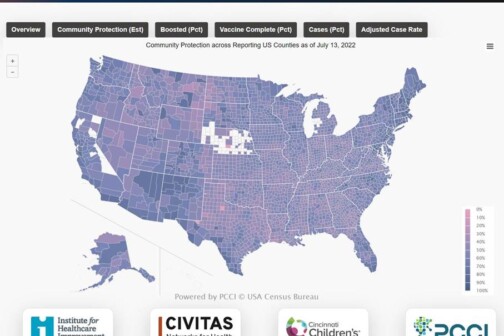Dr. Jeffrey Kahn stood next to an unvaccinated child in the intensive care unit at Children’s Medical Center, the patient’s parents flanking the bed. The child, who had been infected with COVID-19, was hooked up to a ventilator. Though their answer wouldn’t affect the care he provided to the child, he asked the parents if they would vaccinate their child if they could do it all again.
“It’s startling,” says Kahn, the director of the pediatric infectious disease at UT Southwestern Medical Center and the director of infectious diseases at Children’s. “It speaks to how ingrained some of this nonsense floating around out there is. It’s mind-bending, at times.”
As misinformation and debates swirl around the vaccine, the number of cases in children and adults has increased dramatically in North Texas. Last year, Dallas-Fort Worth area pediatric cases reached their peak after six to eight weeks of buildup during the wave of the delta variant.
This time around, the pediatric cases are close to exceeding the previous peak after just a couple weeks of acceleration. And while most of the COVID-positive patients at Children’s Medical Center are hospitalized with COVID-19 rather than because of it, there are still plenty of severe COVID-19 infections. Overall hospitalizations are not increasing in the region—the 19-county service area is steady at 93 percent occupancy, as it has been since October 2020—and Kahn says many patients are arriving in the hospital for other reasons and finding out they have COVID once they arrive.
Kahn says he’s seeing hospitalized patients who are younger than those who occupied beds during past waves of the virus. The omicron variant is infecting more infants and young children, and a couple of factors are responsible. This variant is much more contagious, and children younger than five cannot be vaccinated. That means more small children with severe cases.
The symptoms are similar to past variants, Kahn says, and the medical staff has contained spread within the hospital. The community, however, is a different story. The hospital has been working at max capacity for months, so it will be difficult to add capacity or beds if the additional cases do increase total hospitalizations. “People have been working tirelessly throughout the pandemic, and this, of course, is adding an extra layer of stress,” Kahn says.
Kahn says that things may get worse before they get better. Texas is a couple of weeks behind other parts of the country, and if those areas serve as a trajectory for our case numbers, Texas is destined to see more cases. “Things are going to get a lot worse over the next several weeks. I think the numbers are going to continue to skyrocket.”
What is especially troubling is that the vast majority of the patients sick with COVID-19 are unvaccinated, Kahn says. Since the delta variant spiked pediatric cases this summer, Kahn has publicly preached the importance of vaccination among families who are resistant to getting the jab. Like any treatment, there are risks and potential side effects, but data have shown that the risks from the virus are significantly higher than those of the vaccine. “We have two great foes. One is the virus, and the other is this misinformation or disinformation that’s circling circulating out there,” he says.
According to data from the Parkland Center for Clinical Innovation, 94 percent of the children in Dallas County under 10 years of age are not vaccinated. Only one in three children aged 10-14 are vaccinated. While most children experience few or no symptoms, the more children exposed, the more likely a severe case will occur.
The omicron variant has had less of an impact on the public’s behavior as health officials would like. While omicron has not caused a significant increase in local vaccinations, there appears to be a continuous flow of patients getting vaccinated and boosted. Currently, 64.5 percent of Dallas County is vaccinated, but only 15 percent has received a booster. Combined with the rampant spread of the virus, PCCI CEO Steve Miff says a silver lining is that Dallas County will emerge on the other side of this wave with increased immunity. The vaccine and booster are more effective than natural immunity, but it all could help move the region toward an endemic status for the virus.
“Some protection is better than none, so that’s going to elevate the level for everybody,” Miff says. “Hopefully, this can get us over the hump, and the signs are there that it could.”
Despite the uphill battle, pediatric providers continue to use different strategies to encourage families to vaccinate their children. “I try to stay away from banging people over the head with a lot of numbers and data because then it just becomes a number soup,” he says. “I talk about my experiences and how this all could have been prevented. You don’t want to have that regret.”
Get the D CEO Healthcare Newsletter
Author






